Bikram Yoga: Why the Heat?
Why is it so hot in a Bikram yoga studio? The heat actually works to loosen your muscles. This in turn allows you to move more fluidly into a deeper yoga pose. Also, the heat challenges you to move past your comfort level into a focused mental state. Finally, the heat also helps you sweat, which facilitates the removal of toxins in your body.
Basic Yogic Meditation
Here is a basic technique in yoga meditation for beginners: Sit cross-legged on a cushion, on the floor, with good comfortable posture. Press tongue to palate, close your mouth without clenching the teeth, and lower the eyelids. Breathe naturally through the nose, down into the abdomen and then exhale with a long and smooth breath. Focus your attention on "above and below" sensations. Above, concentrate on the breeze of air flowing in and out of the nostrils. Below, focus on the navel rising and falling and the entire abdomen expanding and contracting like a balloon with each inhalation and exhalation. You can choose to focus attention on the nostrils or the abdomen, or on both at the same time.
"Easy Does It Yoga"
The American Yoga Association's "Easy Does It Yoga" program is designed for the elderly or anyone with physical limitations. Developed in the 1960s the program student's manual "provides a comprehensive routine of exercise, breathing, and meditation, many of which are designed for chair or bed."
Hatha Yoga: Pranayamas
Pranayamas, or breathing exercises, are extremely important to practicing Hatha yoga properly. Once the breath is controlled, the mind is controlled, according to the yogis. Our energy (Prana) is altered though the exercises, which often involve deep inhalations (usually through the nose), exhalations (through the mouth), and even holding the breath for a few counts. These practices prepare the way for Samadhi (enlightenment). Pranayama practice is also a vital part of Kundalini yoga.
Improvement Time
Beginners often wonder how long it will take before postures get easier. While there's no simple answer to that question, you will notice that if you practice consistently (on a daily or weekly schedule) rather than intermittently postures gradually become less difficult. If you find you hurt after practice, try doing shorter, more frequent sessions to improve your flexibility.
The Best Time To Take Yoga Class
When is the best time to take a yoga class? There are benefits to morning, day, and night time classes. Early morning yoga -- often held around sunrise -- is a great way to open your channels and start the day. During an afternoon slump, a yoga class is a perfect pick-me-up, and certainly better for you than a candy bar! However, you should be aware that after a yoga class the body and mind might not be in the best state to attend an important meeting or meet a deadline. Be sure to allow time after class until you know how you will adapt to yoga. Evening or night time classes are ideal to put you into a state of relaxation that will allow you to have a deep and restful sleep.
Differences: Yoga vs. Pilates
There are both differences and similarities between Yoga and Pilates. The biggest difference is that Pilates uses a line of equipment that does not exist in yoga. But the theory of mind-body connection exists in both Yoga and Pilates. They also share a fluidity of movement.
Insomnia
Sometimes it´s hard to turn off the day and relax enough to fall asleep. We all have those nights.
If you can´t sleep, try using calming poses to help you relax - forward bends, gentle twists, and simple inversions are good choices. Remember to breathe slowly and fully. This will also help you relax.
Beginners
When you're starting out, the important thing to focus on during your yoga practice is the balance between body and mind. You want to perform poses to the best of your ability, without stress or strain, and to remember to breathe. Your flexibility and the duration you can hold positions will increase over time.
Footwear
You should NOT wear shoes when doing yoga.
Having bare feet when you practice will help you to have proper balance and stability. However, since maintaining a comfortable temperature is also important, you can wear socks if the floor surface is cold.
Benefits
Headstand, and other inverted poses, increase circulation, stimulate the brain, enhance glandular system functioning, and relieve pressure on the abdominal organs.
Remember that pregnant or menstruating women should NOT do inverted poses.
Yoga for Weight Loss
One of the five principles of yoga is diet. Think of your body as an instrument through which you can play the music of the universe. Like any instrument, you want to keep it well cared-for. By eating healthy -- vegetables, fruits, whole grains and limited (or no) meat products -- you will develop a stronger leaner body, especially as you practice your yoga technique. Yoga also has many physical benefits, including a leaner body, a straighter posture and more defined muscle tone. With all this in mind, it's easy to see why so many choose to use yoga for weight loss and generally better living.
Eight Limbs
Traditional yoga has eight steps, or limbs, for guidance in living a meaningful and purposeful life. They are: Yama, moral disciplines; Niyama, self disciplines; Asana, postures; Pranayama, breath control; Pratyahara, sensory withdrawal; Dharana, concentration; Dhyana, meditation; Samadhi, transcendence.
 Another great benefit of Yoga is its ability to reduce weight. Through different asanas of Yoga we can easily reduce extra fat from our body. Some of the asanas stimulate sluggish glands to increase their hormonal secretions. For example, the thyroid gland has a big effect on our weight as it affects body metabolism. Asanas like shoulder stand and the fish posture are particular for the thyroid gland. These asanas increase fat metabolism thereby converting fat to muscle and energy. This is like killing two birds by a single stone. You will not only loose fat but also have a better muscle tone and vitality.
Another great benefit of Yoga is its ability to reduce weight. Through different asanas of Yoga we can easily reduce extra fat from our body. Some of the asanas stimulate sluggish glands to increase their hormonal secretions. For example, the thyroid gland has a big effect on our weight as it affects body metabolism. Asanas like shoulder stand and the fish posture are particular for the thyroid gland. These asanas increase fat metabolism thereby converting fat to muscle and energy. This is like killing two birds by a single stone. You will not only loose fat but also have a better muscle tone and vitality. 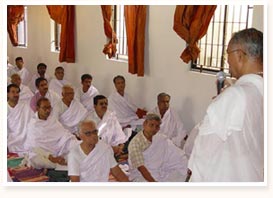 Yoga helps an individual not only to realize his own self but also understand other issues around him/her. Yogic theory and practice lead to increased self-knowledge. Yogic practices like breathing and posture exercises help in attaining and maintaining health, physical and mental, and relaxation. The knowledge gained through Yoga is not simply that of the practical kind relating to techniques, but of a spiritual sort pertaining to grasping something about the nature self and other matters.
Yoga helps an individual not only to realize his own self but also understand other issues around him/her. Yogic theory and practice lead to increased self-knowledge. Yogic practices like breathing and posture exercises help in attaining and maintaining health, physical and mental, and relaxation. The knowledge gained through Yoga is not simply that of the practical kind relating to techniques, but of a spiritual sort pertaining to grasping something about the nature self and other matters. 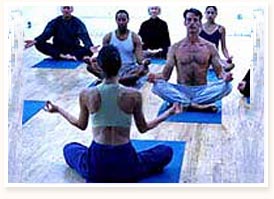 Like all other issues, Yoga's view of sex is also that of adherence to the middle path. It has been proved beyond doubt that a fulfilling sexual life is necessary to lead a happy life. Yoga considers sex to be a natural function, very helpful in a loving relationship and, of course, indispensable for the continuation of the human race on the earth. Yoga has a clear cut demarcation; do not indulge in over sex as it may diminish the force and pace of life.
Like all other issues, Yoga's view of sex is also that of adherence to the middle path. It has been proved beyond doubt that a fulfilling sexual life is necessary to lead a happy life. Yoga considers sex to be a natural function, very helpful in a loving relationship and, of course, indispensable for the continuation of the human race on the earth. Yoga has a clear cut demarcation; do not indulge in over sex as it may diminish the force and pace of life. 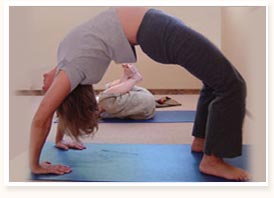 Along with many other advantages, Yoga also possesses the magic power of healing. Yoga has been used for healing disorders such as acid stomach, asthma, bronchitis, cancer, constipation, heart disorders, hypertension, insomnia, menstrual disorders, obesity, sinus and a number of other diseases. The healing power of Yoga is so great that it is being assessed for its potential in treating illness like sclerosis, cerebral palsy and osteoporosis. Another example of healing power of Yoga is that it can allow people to control a variety of body functions including blood pressure, body temperature, heart rate, metabolic functions and so on. Studies have proved that people who regularly practice Yoga have reduced anxiety, are more resistant to stress, have lower blood pressure, efficient heart function and overall improved physical fitness.
Along with many other advantages, Yoga also possesses the magic power of healing. Yoga has been used for healing disorders such as acid stomach, asthma, bronchitis, cancer, constipation, heart disorders, hypertension, insomnia, menstrual disorders, obesity, sinus and a number of other diseases. The healing power of Yoga is so great that it is being assessed for its potential in treating illness like sclerosis, cerebral palsy and osteoporosis. Another example of healing power of Yoga is that it can allow people to control a variety of body functions including blood pressure, body temperature, heart rate, metabolic functions and so on. Studies have proved that people who regularly practice Yoga have reduced anxiety, are more resistant to stress, have lower blood pressure, efficient heart function and overall improved physical fitness. 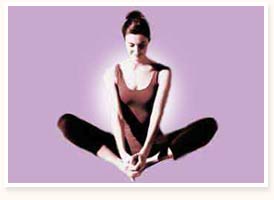 There is hardly anything on this earth which is not touched by Yoga. Yoga not only increases the physical strength but also the grace and beauty of the face. Yogic practices bring beauty of figure, graceful carriage; melodious voice, glowing face and charming smile. If practiced regularly, Yoga asanas help men and women to acquire a figure that enhances their beauty and gives them flexibility. Beauty coupled with flexibility gives them charm and elegance in every body movement. Individuals practicing Yoga are endowed with a peculiar glow on their faces. Yoga creates a certain aura around that individual, which attracts other people towards them. Many film stars, industrialists and other famous personalities have taken to Yogic practices over time to make themselves fit and beautiful according to the demands of their profession. To look beautiful one has to remain free of all worries and tensions. Yoga helps an individual to attain these attributes.
There is hardly anything on this earth which is not touched by Yoga. Yoga not only increases the physical strength but also the grace and beauty of the face. Yogic practices bring beauty of figure, graceful carriage; melodious voice, glowing face and charming smile. If practiced regularly, Yoga asanas help men and women to acquire a figure that enhances their beauty and gives them flexibility. Beauty coupled with flexibility gives them charm and elegance in every body movement. Individuals practicing Yoga are endowed with a peculiar glow on their faces. Yoga creates a certain aura around that individual, which attracts other people towards them. Many film stars, industrialists and other famous personalities have taken to Yogic practices over time to make themselves fit and beautiful according to the demands of their profession. To look beautiful one has to remain free of all worries and tensions. Yoga helps an individual to attain these attributes.  At times we all feel heavy, down and out, tired and weak. The whole strength of our body seems to have lost. But on the other hand when we feel energetic and strong, life doesn't seem so difficult. It is very natural that the weaker you are the heavier you will feel. On the contrary the stronger you are the better you feel. When practiced regularly, Yoga makes you strong and light. It is unbelievable that one feels twice as strong as before but at the same time he/she feels half his/her earlier body weight. Yoga makes you feel totally different than what you were earlier. Your everyday experience is completely changed the moment you come in the fold of Yoga. With increase in strength the whole tendency of your body changes. Despite the increase in your body weight you find the handling of your body more easy and comfortable. From then onwards your experience of this world will become nicer and life will become easier. Thus, Yoga has the power not only to increase your mental but physical attributes as well.
At times we all feel heavy, down and out, tired and weak. The whole strength of our body seems to have lost. But on the other hand when we feel energetic and strong, life doesn't seem so difficult. It is very natural that the weaker you are the heavier you will feel. On the contrary the stronger you are the better you feel. When practiced regularly, Yoga makes you strong and light. It is unbelievable that one feels twice as strong as before but at the same time he/she feels half his/her earlier body weight. Yoga makes you feel totally different than what you were earlier. Your everyday experience is completely changed the moment you come in the fold of Yoga. With increase in strength the whole tendency of your body changes. Despite the increase in your body weight you find the handling of your body more easy and comfortable. From then onwards your experience of this world will become nicer and life will become easier. Thus, Yoga has the power not only to increase your mental but physical attributes as well. 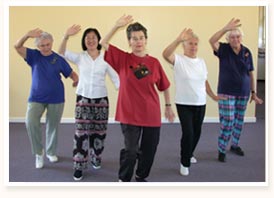 Yoga and social values are closely related to each other. Social values are a set of philosophy that an individual carries for all his life. Yoga possesses great power to inculcate those values that go a long way in making a man complete. With Yoga along your side you have the luxury to tackle any tricky situations that you come across in your day to day life.
Yoga and social values are closely related to each other. Social values are a set of philosophy that an individual carries for all his life. Yoga possesses great power to inculcate those values that go a long way in making a man complete. With Yoga along your side you have the luxury to tackle any tricky situations that you come across in your day to day life. 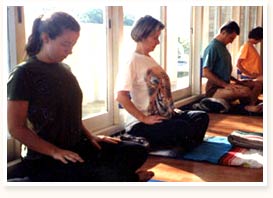 Yoga and mental health are closely interrelated. Persons practicing Yoga experience tremendous changes that result in a deep effect on their mental health. Reduction of tension and restoration of flexibility are some of the mental health benefits derived from Yoga. Yoga helps in freeing the mind from mental disturbances. Yoga also steadies the mind. Decrease in nervousness, irritability and confusion, depression and mental fatigue are some of the other mental health benefits experienced from practicing Yoga. The benefits accrued through Yoga differ from person to person as the degree of involvement differs.
Yoga and mental health are closely interrelated. Persons practicing Yoga experience tremendous changes that result in a deep effect on their mental health. Reduction of tension and restoration of flexibility are some of the mental health benefits derived from Yoga. Yoga helps in freeing the mind from mental disturbances. Yoga also steadies the mind. Decrease in nervousness, irritability and confusion, depression and mental fatigue are some of the other mental health benefits experienced from practicing Yoga. The benefits accrued through Yoga differ from person to person as the degree of involvement differs. 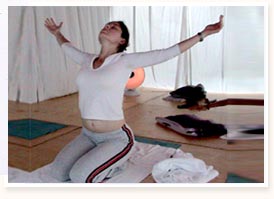 Yoga plays an important role in shaping our love life. There can't be two opinions about the fact that our life is shaped by our thoughts and the way we interpret things and situations. All thoughts, feelings and emotions manifest in one form or the other in our body and life. As you become more sensitive to your inner feelings you notice nice thoughts coming to your mind. All this leads to one simple truth; nice thoughts generate nice feelings. Here comes the importance of Yoga. The primary and most important theme of yoga is learning to love and be loved. Yoga helps the energy of love to flow freely through you once you start practicing it.
Yoga plays an important role in shaping our love life. There can't be two opinions about the fact that our life is shaped by our thoughts and the way we interpret things and situations. All thoughts, feelings and emotions manifest in one form or the other in our body and life. As you become more sensitive to your inner feelings you notice nice thoughts coming to your mind. All this leads to one simple truth; nice thoughts generate nice feelings. Here comes the importance of Yoga. The primary and most important theme of yoga is learning to love and be loved. Yoga helps the energy of love to flow freely through you once you start practicing it. 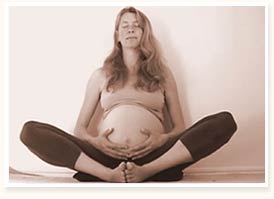 Along with a host of benefits, Yoga also helps in developing and attaining personal values. Yoga erases a variety of ills in human beings. These may range from feelings of frustration, persecution and insecurity. Yoga greatly helps in the development of personal values. Personal values are those values which an individual develops and lives by all through his life. The main aim of life is to enjoy every moment and Yoga indeed plays a vital role in this regard. Yoga makes life better. Yoga is a continuing process and a life long thing, not just something you do for a while and stop. We all strive for improvement throughout our lives. It is an indication of our resolve to improve and remain fit. Yoga helps us to attain these goals.
Along with a host of benefits, Yoga also helps in developing and attaining personal values. Yoga erases a variety of ills in human beings. These may range from feelings of frustration, persecution and insecurity. Yoga greatly helps in the development of personal values. Personal values are those values which an individual develops and lives by all through his life. The main aim of life is to enjoy every moment and Yoga indeed plays a vital role in this regard. Yoga makes life better. Yoga is a continuing process and a life long thing, not just something you do for a while and stop. We all strive for improvement throughout our lives. It is an indication of our resolve to improve and remain fit. Yoga helps us to attain these goals.  Flexibility and Yoga go together. With increased flexibility many tensions and conflicts are erased on their own. The more flexible a body the better it is for that individual. It saves your body from unnecessary torture and pain. Pain and stress are forms of blocked, jammed, misplaced and misused energy. Being more flexible means opening these energy blockages and freeing your energy circulation. As the blocked energy is freely circulated, your complete body will feel clean and new because the trapped parts are freed and released. And Yoga helps in making your body completely flexible and comfortable.
Flexibility and Yoga go together. With increased flexibility many tensions and conflicts are erased on their own. The more flexible a body the better it is for that individual. It saves your body from unnecessary torture and pain. Pain and stress are forms of blocked, jammed, misplaced and misused energy. Being more flexible means opening these energy blockages and freeing your energy circulation. As the blocked energy is freely circulated, your complete body will feel clean and new because the trapped parts are freed and released. And Yoga helps in making your body completely flexible and comfortable.  Improvement in balance is one of the major benefits of Yoga. Improved balance is referred not only to the sharp physical coordination but also to the balance between the left and right, front and back and high and low aspects of one's body. As far as balance of the body is concerned, hardly few of us have proper balance. We may be stronger on one side but weaker on the other side. Similarly, we can turn our head or twist our spine more in one way than the other. We can bend forward with ease but not backward.
Improvement in balance is one of the major benefits of Yoga. Improved balance is referred not only to the sharp physical coordination but also to the balance between the left and right, front and back and high and low aspects of one's body. As far as balance of the body is concerned, hardly few of us have proper balance. We may be stronger on one side but weaker on the other side. Similarly, we can turn our head or twist our spine more in one way than the other. We can bend forward with ease but not backward.  There is a very famous concept in Yoga philosophy. According to it a person's age is determined by the flexibility of his spine, not the number of years he has lived. Yoga helps in slowing down the aging process by providing elasticity to the spine, firming up the skin, removing tension from the body, strengthening the abdominal muscles, eliminating the likelihood of a double chin, improving the quality of loose arm muscles, correcting poor posture and so on. Thus, of the numerous benefits of Yoga, anti-ageing is an important one.
There is a very famous concept in Yoga philosophy. According to it a person's age is determined by the flexibility of his spine, not the number of years he has lived. Yoga helps in slowing down the aging process by providing elasticity to the spine, firming up the skin, removing tension from the body, strengthening the abdominal muscles, eliminating the likelihood of a double chin, improving the quality of loose arm muscles, correcting poor posture and so on. Thus, of the numerous benefits of Yoga, anti-ageing is an important one. 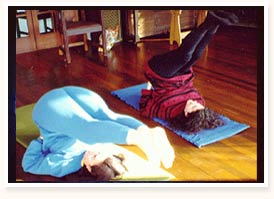 The benefits of Yoga are numerous. In terms of energy Yoga is like a universe in itself. Some of the important Yoga benefits include anti-ageing, balance and flexibility of body, increase in knowledge and wealth, improvement in mental health and development of personal and social values. This is not the end of story; Yoga also helps in improving strength, sexual life and reducing weight. Yoga makes you feel good. Yoga is relaxing. It's energizing. It's strengthening.
The benefits of Yoga are numerous. In terms of energy Yoga is like a universe in itself. Some of the important Yoga benefits include anti-ageing, balance and flexibility of body, increase in knowledge and wealth, improvement in mental health and development of personal and social values. This is not the end of story; Yoga also helps in improving strength, sexual life and reducing weight. Yoga makes you feel good. Yoga is relaxing. It's energizing. It's strengthening.